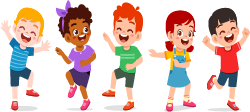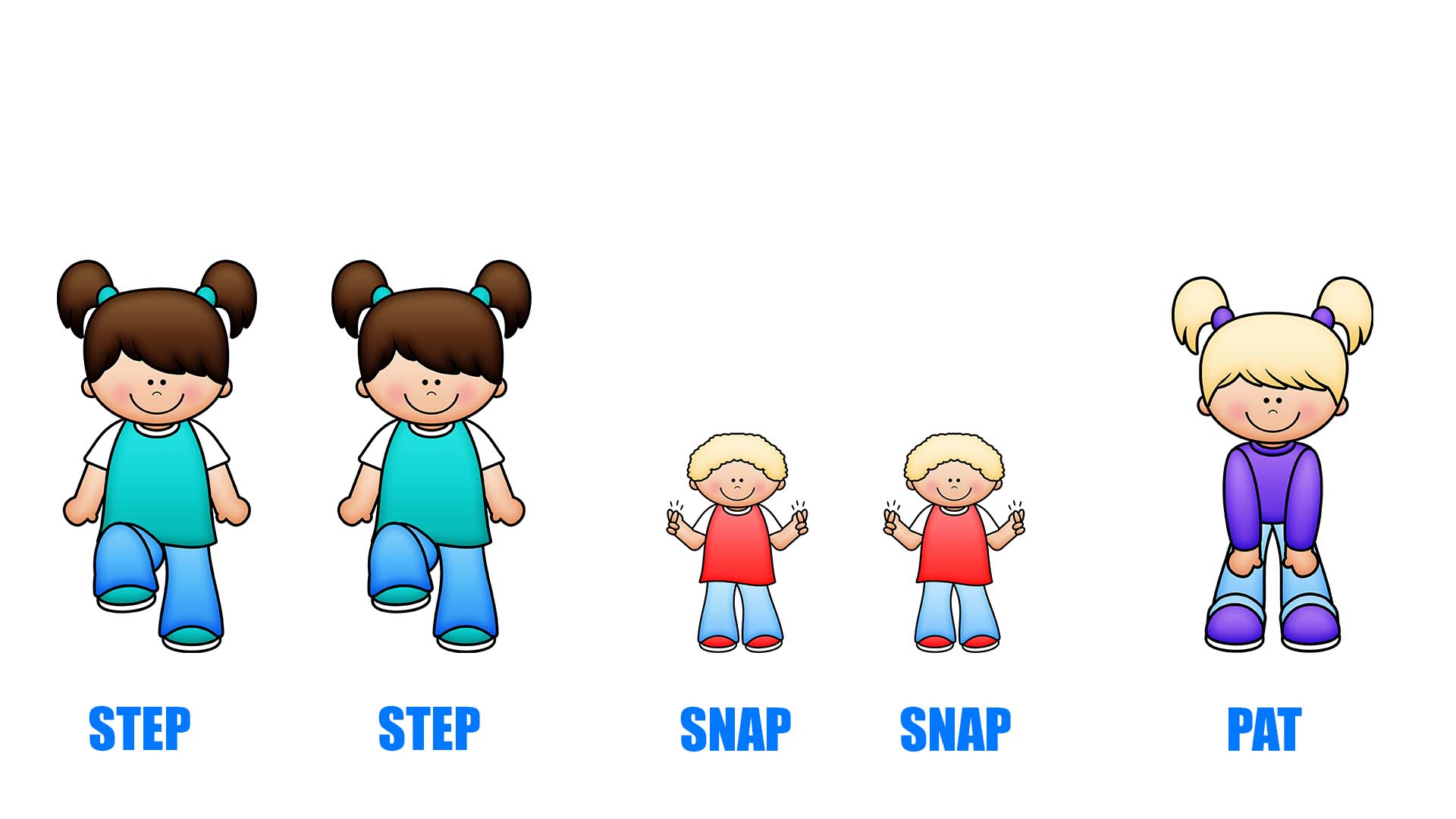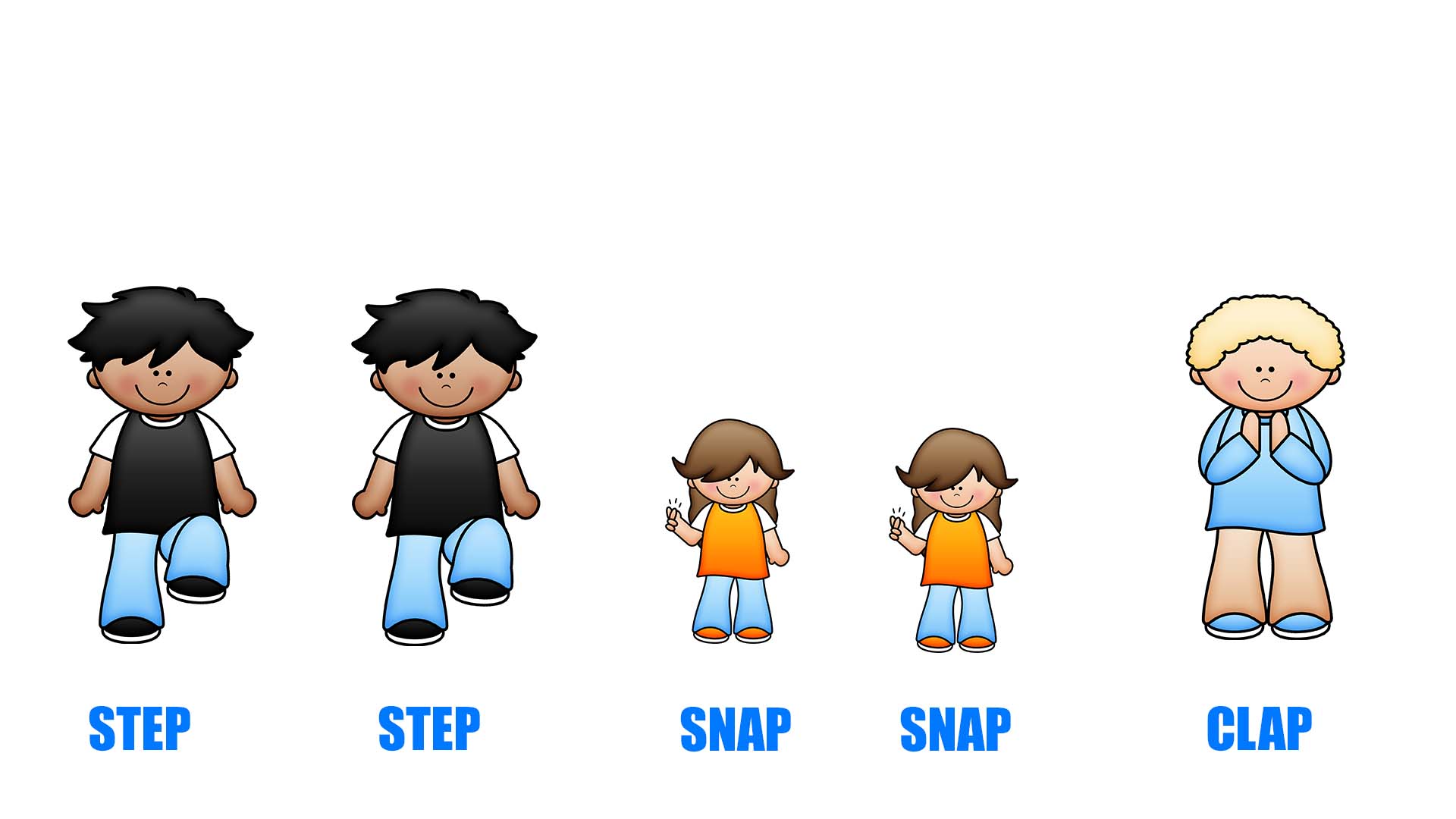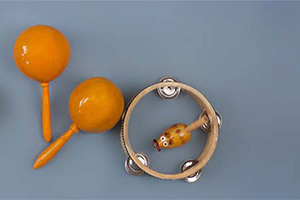Prep. Lesson 16. Rhythm patterns I
Prior learning: None
Duration: 30 minutes
Materials: Pig puppet
Keywords: Beat, singing, chanting, partners, rhymes, circle games
Difficulty: ![]()
 Melodic development
Melodic development
![]() Students discover that rhythm is the way the words go.
Students discover that rhythm is the way the words go.
- "Clap Your Hands" serves as an effective tool for engaging children in coordinated body movements and singing activities.
- Students will clap the words, and in so doing, rhythm is described as "the way the words go".
- The song's rhythm is inherently linked to its syllables, creating a structure that encourages students to clap and sing syllables during the initial portion of the song, followed by patting their heads in the latter half.
- This approach fosters a sense of rhythm and develops motor skills and coordination.
- To extend the activity and enhance its versatility, consider improvising by replacing the original words with alternatives such as "shake" and "stamp" (or "patsch" and "click").
- This adaptation stimulates creativity while encouraging students to explore various body movements, providing a more comprehensive learning experience.
- By incorporating these modifications, educators can create a dynamic and interactive environment that promotes active participation, motor skill development, and rhythmic understanding in children.
- This approach contributes to a well-rounded and engaging learning experience, effectively combining movement and auditory elements.
 Game
Game
![]() Students repeat rhythmic body movements by the teacher.
Students repeat rhythmic body movements by the teacher.
Lyrics
Hey *Johnny* [Students name]
You think that you're right?
I’ll meet you round the corner,
on a Saturday night.
You can wiggle, you can waddle,
You can do the twist.
But I bet ya, I bet ya,
You can’t do this!
[Note: Dr James Cuskelly uses a slightly different lyric in the video]
- Introduce the song and its movements to the class, ensuring a clear and concise explanation to facilitate understanding. The primary objective is for students to learn and imitate the rhythm patterns presented by the teacher.
- Begin by selecting a student and playfully asking if they believe they can execute the movements correctly while pointing at them. Proceed by gesturing over your shoulder, indicating a meeting point on a Saturday night. This establishes a sense of anticipation and engagement.
- Demonstrate a dance sequence that involves wiggling, waddling, and twisting, highlighting the importance of coordination and fluidity in the movements.
- After completing the dance sequence, present a simple rhythmic pattern using hands and feet. This pattern is essential for students to mimic, encouraging active participation and reinforcing their understanding of rhythm.
- Repeat the entire process, choosing a different student each time and incorporating unique rhythmic sequences to maintain interest and challenge the students' ability to adapt to new patterns.
- This iterative approach promotes a dynamic learning environment and fosters the development of rhythm and movement skills in students.
 Rhythmic development
Rhythmic development
![]() The teacher establishes simple rhythm patterns for students to copy using a rhyme and puppet.
The teacher establishes simple rhythm patterns for students to copy using a rhyme and puppet.
Lyrics
I had a little pig,
And I fed him in a trough.
He got so fat,
That his tail popped off!
I got me a hammer,
And I got me a nail,
And I made my pig
A brand-new tail.
- Present the rhyme to the class, maintaining a measured cadence while performing the puppet play according to the video.
- Once again, this activity allows students to understand rhythm as "the way the words go".
- This captivating rhyme serves not only as entertainment but also as an effective rhythm exercise for students.
- Employ a pig puppet to recite the rhyme, allowing it to "speak" while encouraging the class to participate in unison. This interactive approach fosters engagement and reinforces rhythm learning.
- Upon completing the rhyme, introduce a simple rhythm pattern by striking the sticks together. Instruct students to mimic this pattern by tapping their knees, ensuring they copy the rhythm.
- Next, select a student to come to the front of the class and provide them with sticks. Prompt them to reproduce the rhythm pattern, allowing them to demonstrate their understanding of the rhythm.
- Repeat this process, incorporating a new rhythm pattern for the class. Involve another student in the exercise, giving them the opportunity to showcase their ability to adapt to different rhythm patterns.
- By iterating this procedure, students gain exposure to various rhythm patterns, promoting active participation and enhancing their rhythmic skills.
 Part work
Part work
![]() Students identify rhythm through activities using movement and singing.
Students identify rhythm through activities using movement and singing.
- "Hey Hey, Look At Me" is an engaging song encouraging students to participate in body movement and singing activities.
- Divide the class into two groups: one will maintain the beat by stamping while singing, and the other will preserve the rhythm by clapping with their singing.
- This approach cultivates an interactive and dynamic learning environment that promotes active participation, rhythmic understanding, and motor skill development.
- By dividing the class into two groups with distinct roles, students can experience different aspects of rhythm and beat, fostering a more comprehensive understanding of musical elements.
- Furthermore, this method stimulates cooperation and coordination among classmates, enhancing the overall learning experience.

 Visual learning
Visual learning
![]() Students use body percussion and respond to simple rhythm patterns.
Students use body percussion and respond to simple rhythm patterns.


 Visual learning
Visual learning
![]() Zak and Zoe identify rhythm patterns in speech.
Zak and Zoe identify rhythm patterns in speech.
 Farewell
Farewell
![]() Reinforces students' pitch ability through listening, imitation, and repetition. 'Good morning' or 'Bee, Bee, Bumblebee' are good examples.
Reinforces students' pitch ability through listening, imitation, and repetition. 'Good morning' or 'Bee, Bee, Bumblebee' are good examples.
Suggested lessons
Prep. Lesson 17. Sound and silence
 Students distinguish sound from silence. AC9AMUFP01
Students distinguish sound from silence. AC9AMUFP01
Prep. Lesson 18. Inner hearing
 Students explore active listening and inner hearing through singing, movement and props. AC9AMUFP01
Students explore active listening and inner hearing through singing, movement and props. AC9AMUFP01
Prep. Lesson 19. Rhythm patterns II
 Students explore rhythm by using body percussion and percussion instruments. AC9AMUFP01
Students explore rhythm by using body percussion and percussion instruments. AC9AMUFP01
